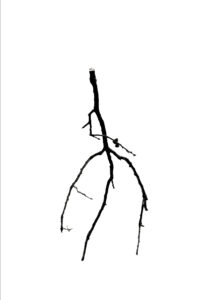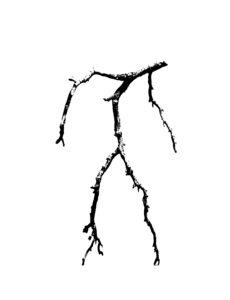When I looked at Michael Eastman’s twig sculptures, I saw people. A man reaching out to his child. A woman flirting. Curious what this revealed about my psyche, I casually mentioned the experience to Robert Cloninger, emeritus professor of psychiatry at Washington University. “These twigs could be a Rorschach inkblot test!” I told him. “I keep seeing human figures in them. . . .”
Cloninger, a psychiatrist and a geneticist who has studied the evolution of human creativity and pattern recognition, was not in the least bit surprised. Our connection with nature is well-established, he reminded me. Being in a forest calms us; green spaces are healing and restorative.
But why was I seeing people in trees? Granted, we see a man in the moon and critters in the clouds. But these associations felt more immediate and direct, received rather than dreamed up.
We decided to try using the images on somebody else—I would let Cloninger pick the person—to see what they saw, and what he, as a psychiatrist, made of their response.
Instantly on board, Eastman printed up flashcards from a series he is having cast, many times larger than life, in bronze. Now a big project, the twig series started when he picked up a few interesting branches after a storm and began breaking off bits here and there, instinctively sculpting to reveal “something that is there but not easily visible.” Years as a world-class photographer had taught him to see possibilities that do not register with the rest of us, and he chipped away until the figure emerged. He also made sure to end with a sculpted form that could stand on its own, which heightened the sense of aliveness. He was now seeing “what we see in all beings: two ‘legs,’ a ‘torso,’ and ‘arms.’”
I blew out a relieved exhale; I had not been projecting and anthropomorphizing for no reason. These were tree people. I carried the stack of flashcards, wrapped in brown paper and tied up with string, to Cloninger, who passed them on to his subject, a woman who loves art and pays close attention to the visual.
Up for the game, she studied each image in turn. First, she was struck by the reminder, amid “all the stress and chaos in our lives worldwide, that people can still relax in nature and commune with it peacefully. Not to mention, see winks of bliss in the simplest of natural elements.” She loved the delicacy of the twigs, and the way Eastman preserved that feeling even as he strengthened them in an armature of bronze. The sense of lithe movement in most of the images reminded her of “a dance in nature, similar to Botticelli’s Spring. The figures often seem to reach towards the sky,” lighthearted and joyful.
Next she went through the series again, reacting to each image with a description of what she saw, then what she felt.
- A person bending forward looking down for something below. Worrying, hoping to find what was dropped
- A lady in a long gown, bending forward and reaching out. Seeking help, hopeful that someone will respond
- Two people using their heads to support another person, who is above them and leaning backwards. Perhaps acrobats. Happiness because you are helping someone else
- One person walking, dragging an object of some sort. A determined, hurried feeling of wanting to escape
- A person is walking quickly to get away, but a child has grabbed their arm and is hanging from it. Wanting freedom from some burden
- An elegant lady wearing a long ballgown leans slightly backwards with her arm extended, decorated with a pretty bracelet. A feeling of happiness about oneself and a bit of showing off!
- A large man is falling backwards, but he is being supported by an adult and a teenager. A feeling of failing, yet being happy because your family or friends are so helpful
- A person, perhaps a female wearing decorations on her arms, reaching forward, trying to move away while a smaller person is grabbing her from behind. Trying to break away from some burden
- One large person being supported and balanced by two others, one medium size and the other smaller, perhaps in a balancing act of some sort. The comfort of a supportive family
- A person trying to right himself, with his arm extended forward, while a child tries to help by pushing the legs forward. A feeling of struggling, hoping not to fall
- An animal of some sort, leaning forward, looking downward. A searching, inquisitive, joyful feeling
- A large person falling backward with a smaller one trying to help. Another hopeful et happy feeling or not falling or failing backwards
- A man walking, his arms extended, reaching out. A secure feeling of happiness, reaching out toward another
- One strong man leans forward, supported by two others. Perhaps an acrobatic act of some sort? A secure feeling of success
- A person leaning backwards against a large tree trunk with branches hanging down. A happy, relaxed, and meditative feeling of calmness
Cloninger read through these responses, impressed by the creativity of Eastman’s artistic process (who knew a twig could say so much?) and by the visual and emotional interpretations the figures had evoked. “I’ll focus my comments on the psychological processes that make art involving natural figures so powerful,” he told me. “And on what this reveals about our relationship to nature and to one another.”

Twig figure 6. (Michael Eastman)
The woman who had volunteered to interpret the images told him she felt “touched from within and without.” For example, Cloninger says, “she felt hopeful calling for help and happiness from helping another in figures 2, 3, and 11. She sensed someone struggling with a burden and seeking freedom and escape (figure 8) or support from others (figures 7 and 9). She also felt security and satisfaction from successful accomplishments (figure 13) or calm meditation (figure 14), and joyful inquisitiveness in others (figures 6 and 11).
“Of course, responses to ambiguous forms drawn from nature are shaped and colored by the personality and emotional state of the observer,” he continues, “as has been documented in studies of projective tests like the Rorschach tests. However, an artist can also create patterns that are likely to allow an observer to share his own vision.” Eastman did just that, and his creativity evokes a creative response—but that does not end the mystery.
“How and why do we respond to the branched forms of broken twigs so strongly, as if they represented people with whom we can empathize?” Cloninger asks, reading my mind. “Why do we see human figures and social relationships in fragments of trees? Why do they evoke such heartfelt emotions?” The answer lies in the way our brain works, he says, and more specifically, in our relationship to trees—and it just might hint at “the pathway to a healthy and happy life.”
Which is more than I anticipated.
He begins with the role of nature: “Feelings of calm, hope, and appreciation of beauty are frequently evoked when we walk in a forest or a garden, or even when we see images of trees, plants, flowers, or seashells.” Why? Because they allow us to “identify with our surroundings rather than being self-preoccupied and alienated from others.” This sort of self-transcendence is therapeutic; it leaves us healthier. By the same token, “concrete, artificial urban settings devoid of natural patterns of curves and branches elicit feelings of separation and alienation, predisposing us to self-interest, distrust, and ill-health.” Think of the difference, he suggests, between neighborhoods marked by poverty, violence, and distrust, and neighborhoods with wide swaths of emerald-green lawn, carefully tended gardens, and tree-lined sidewalks. You breathe differently.

Twig figure 1. (Michael Eastman)
Another reason we benefit from immersion in nature might be that “all living things share DNA as their material building code,” and we evolved together, interdependent, with many cooperative and symbiotic relationships. “For example, flowering plants and the ancestors of primates emerged at the same time, so that the successful early primates were those who were most agile in picking fruit from the branches of trees.” As a result, we have coordinated eye-hand movements and tend to gesture with our hands, as well as other body parts, to communicate or express emotions. That sort of body language is easy to recognize in the twig figures of Eastman’s sculptures.
The body communicates through its physical form, its alphabet of movements and postures, but also—as artists, designers, scientists, and mathematicians have recognized for centuries—the ratio of relationships among its components. “The most ubiquitous pattern of development of all life forms is the spiral pattern called the Fibonacci series, in honor of the Italian mathematician who described it in 1202,” Cloninger explains. “The Fibonacci series is the numerical sequence 1, 2, 3, 5, 8, 13, 21, 34, 55, 89, 144 . . . in which each successive number, beginning with 3, is the sum of the prior two numbers. This sequence regularly occurs in multicellular organisms, because cellular growth involves a succession of bifurcations in which new primordial cells are produced where and when there is enough space for their formation.”
Fibonacci spirals are as regular as the growth of crystals; they show up in the alignment of leaves, the number of petals, the branching of a twig. You can also see the Fibonacci sequence in the proportion of our features and limbs. Called the Golden Ratio, its proportions have unified and balanced artistic masterpieces for centuries. Cloninger tosses out examples: Phidias’s Athena sculpture, Leonardo da Vinci’s Last Supper, Botticelli’s Birth of Venus. They used the same ratio for their human figures that the universe uses for plants and animals—and in the shapes and proportions of galaxies.

Twig figure 2. (Michael Eastman)
“When people ponder life on earth and the glory and mysteries of the universe, we identify beauty and meaning in patterns that correspond to the golden section,” he concludes. Is it any wonder we can find ourselves in the moon, the stars, the clouds, and the twiggy branches of a tree?
Eastman was intrigued by the Fibonacci link; he had already marveled at the way “the twigs grow in predictable patterns, but since their growth is infinite, every possibility exists. Yet trees, with their unlimited possibilities of growth, will create images that suggest a human or another mammal.” That is when he steps in, using an eye already trained in design and proportion, and breaks off many, many branches to reveal and strengthen these similarities, suggesting attitude and emotion.
Blown away by the sculptures, Eastman’s neighbors are now commissioning him, and one leaves interesting twigs on his University City porch. Some of them have fallen with wind and heavy rain, others from branches that are dying. All contain possibility, and he breaks it free. The rest of us see the sculptures and let our minds run wild.
Read more by Jeannette Cooperman here.
